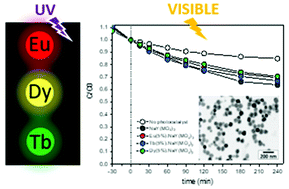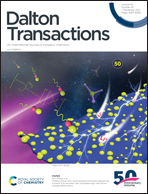NaY(MoO4)2-based nanoparticles: synthesis, luminescence and photocatalytic properties†
Abstract
We report on a novel synthesis method, which produces NaY(MoO4)2 nanoparticles having an almost spherical shape and hydrophilic character. The procedure is also suitable for the preparation of NaY(MoO4)2-based nanophosphors by doping this host with lanthanide cations (Eu3+, Tb3+ and Dy3+), which, under UV illumination, exhibit intense luminescence whose color is determined by the selected doping cation (red for Eu3+, green for Tb3+ and yellow for Dy3+). The effects of the cations doping level on the luminescent properties are analyzed in terms of emission intensities and luminescent lifetime, to find the optimum phosphors. Finally, the performance of these nanophosphors and that of the undoped system for the photocatalytic degradation of rhodamine B, used as a model compound, is also analyzed.



 Please wait while we load your content...
Please wait while we load your content...